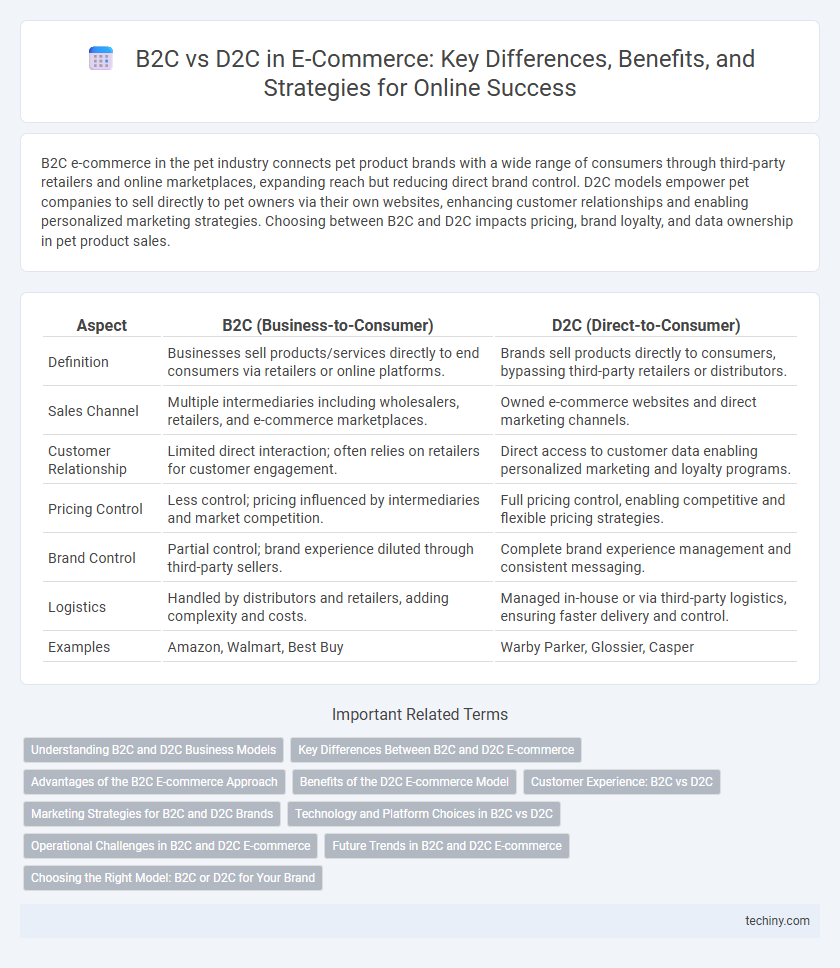B2C e-commerce in the pet industry connects pet product brands with a wide range of consumers through third-party retailers and online marketplaces, expanding reach but reducing direct brand control. D2C models empower pet companies to sell directly to pet owners via their own websites, enhancing customer relationships and enabling personalized marketing strategies. Choosing between B2C and D2C impacts pricing, brand loyalty, and data ownership in pet product sales.
Table of Comparison
| Aspect | B2C (Business-to-Consumer) | D2C (Direct-to-Consumer) |
|---|---|---|
| Definition | Businesses sell products/services directly to end consumers via retailers or online platforms. | Brands sell products directly to consumers, bypassing third-party retailers or distributors. |
| Sales Channel | Multiple intermediaries including wholesalers, retailers, and e-commerce marketplaces. | Owned e-commerce websites and direct marketing channels. |
| Customer Relationship | Limited direct interaction; often relies on retailers for customer engagement. | Direct access to customer data enabling personalized marketing and loyalty programs. |
| Pricing Control | Less control; pricing influenced by intermediaries and market competition. | Full pricing control, enabling competitive and flexible pricing strategies. |
| Brand Control | Partial control; brand experience diluted through third-party sellers. | Complete brand experience management and consistent messaging. |
| Logistics | Handled by distributors and retailers, adding complexity and costs. | Managed in-house or via third-party logistics, ensuring faster delivery and control. |
| Examples | Amazon, Walmart, Best Buy | Warby Parker, Glossier, Casper |
Understanding B2C and D2C Business Models
B2C (Business-to-Consumer) models involve retailers or intermediaries selling products directly to end customers, leveraging platforms like Amazon or Walmart for broader reach. D2C (Direct-to-Consumer) eliminates intermediaries by allowing brands to sell products directly via their own e-commerce websites, enhancing customer data control and personalized marketing. Understanding these models helps businesses optimize sales strategies, customer engagement, and operational efficiency in the competitive e-commerce landscape.
Key Differences Between B2C and D2C E-commerce
B2C e-commerce involves selling products through third-party retailers or marketplaces, while D2C e-commerce allows brands to sell directly to consumers via their own online platforms. B2C relies heavily on intermediaries, leading to wider distribution but reduced control over brand experience and customer data. D2C maximizes profit margins and fosters direct customer relationships by eliminating middlemen and enabling personalized marketing strategies.
Advantages of the B2C E-commerce Approach
B2C e-commerce offers extensive market reach by leveraging established platforms and brand recognition, enabling businesses to attract a diverse customer base efficiently. This approach benefits from reduced marketing costs and streamlined logistics through third-party partnerships, facilitating faster customer acquisition and order fulfillment. Enhanced consumer trust and simplified payment processes further boost conversion rates and drive higher sales volumes in the competitive online retail landscape.
Benefits of the D2C E-commerce Model
The Direct-to-Consumer (D2C) e-commerce model offers brands greater control over customer experience, enabling personalized marketing and direct data collection for improved product development. By eliminating intermediaries, D2C significantly increases profit margins and fosters stronger brand loyalty through direct customer engagement. Enhanced agility in responding to market trends and customer feedback further distinguishes D2C from traditional B2C models reliant on third-party retailers.
Customer Experience: B2C vs D2C
B2C e-commerce platforms often rely on third-party retailers, which can limit direct interaction and personalized experiences with customers, leading to less tailored support and slower response times. D2C brands leverage their control over the entire customer journey, enabling customized marketing, faster feedback loops, and enriched customer engagement through exclusive offers and direct communication channels. Enhanced data collection in D2C models allows for precise customer insights, driving improved product recommendations and personalized shopping experiences that increase customer loyalty and satisfaction.
Marketing Strategies for B2C and D2C Brands
B2C marketing strategies prioritize broad audience targeting through multi-channel campaigns, leveraging social media ads, influencer partnerships, and discounts to drive volume sales. D2C brands focus on personalized customer experiences using data-driven insights, content marketing, and direct engagement to build loyalty and brand community. Both approaches emphasize digital channels but differ in scale and customer relationship depth.
Technology and Platform Choices in B2C vs D2C
B2C e-commerce platforms often rely on established marketplaces like Amazon or eBay, leveraging their extensive infrastructure, payment systems, and customer reach, while D2C brands prioritize customized technology stacks including Shopify, WooCommerce, or bespoke platforms for greater control over user experience and data. B2C technology choices emphasize scalability and integration with third-party logistics and marketing tools, whereas D2C platforms focus on personalized CRM systems, direct customer engagement solutions, and advanced analytics for tailored marketing strategies. The contrasting platform decisions reflect B2C's dependence on broad ecosystem compatibility versus D2C's need for brand-centric flexibility and ownership of customer relationships.
Operational Challenges in B2C and D2C E-commerce
B2C e-commerce faces operational challenges including managing complex supply chains, third-party retailer dependencies, and high customer acquisition costs. D2C models confront issues such as inventory management, direct customer service, and building brand loyalty without intermediary support. Efficient logistics and seamless order fulfillment are critical to overcoming these hurdles in both B2C and D2C frameworks.
Future Trends in B2C and D2C E-commerce
Future trends in B2C and D2C e-commerce emphasize personalized shopping experiences powered by AI-driven data analytics and the expansion of omnichannel retail strategies. B2C platforms are increasingly integrating augmented reality and voice commerce to enhance customer engagement, while D2C brands focus on building direct customer relationships through subscription models and social commerce. Sustainability and ethical sourcing also play a critical role in shaping consumer preferences within both B2C and D2C markets.
Choosing the Right Model: B2C or D2C for Your Brand
Selecting between B2C and D2C models depends on your brand's goals, customer engagement strategies, and control over the customer journey. B2C offers broader market reach through established retailers, while D2C provides direct customer interaction, personalized experiences, and higher profit margins by eliminating intermediaries. Analyzing factors like brand visibility, operational capacity, and data-driven marketing capabilities ensures optimal alignment with your e-commerce objectives.
B2C vs D2C Infographic

 techiny.com
techiny.com